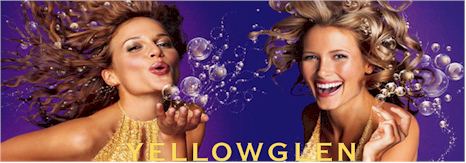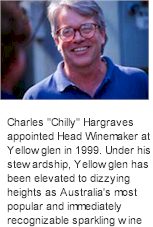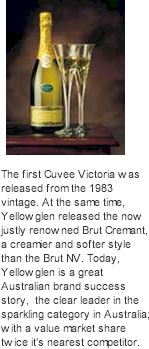


The Yellowglen vineyard at Smythesdale, 18km south west of Ballarat was originally planted to red grape varieties destined for table wine. The name Yellowglen was given to the winery after a gold mine was discovered in the middle of what are now pinot noir sites. It soon became clear however that this cool climate area would be far better suited to the production of world-class sparkling wine. Ian himself recognised that a gap had developed in the market for sparkling wine in Australia. French champagne was priced at $12.99 and Australian sparkling wine at $3.99

Sparkling wine was made for the first time at Yellowglen 1982. Ian Home went into partnership with Dominique Landragin, born and bred in the Champagne region in France. Two years later the classic yellowed labelled Yellowglen Brut NV was released as a premium Australian sparkling wine priced at $6.99. By 1984 Yellowglen had also grown rapidly. Ian and Dominique recognised that capital was required to grow the business to its full potential. Mildara Wines saw the opportunity Yellowglen offered, and took control of the winery that year. Jeffrey Wilkinson from Brown Brothers was employed as head winemaker for Yellowglen in that year.
The first Cuvee Victoria was released from the 1983 vintage. At the same time, Yellowglen released the now justly renowned Brut Cremant, a creamier and softer style than the Brut NV. 1989 The first Yellowglen Vintage wine was released in 1989. It was made from the 1987 vintage and it has gained a reputation as being one of Australia’s finest single vintage sparkling wines.
Following Jeffrey Wilkinson’s departure, the Chief Winemaker for Yellowglen became Adam Eggins, who was Dux of the Oenology Degree at Roseworthy College in 1990. Yellowglen introduced the Y Premium with its unique ceramic printed label, a first in the sparkling wine market, and a blend of wine from Yellowglen’s best vintages. Yellowglen was again at the forefront of innovation when it introduced the Y, its unique and striking ceramic printed label and a more up-front flavoursome Chardonnay driven style ensured it was an immediate success. Yellowglen had cemented itself as Australia’s most successful premium sparkling wine producer.

Yellow Sparkling was successfully launched and became an instant success in 1996. Launched as an entry point into the Yellowglen brand, Yellow was a fun, uncomplicated, casual offering to the consumer. The packaging was simple, the style fresh and flavoursome. The popularity of Yellow grew rapidly and it became a standout success for the brand. In 1999 Charles ‘chilly’ Hargrave was appointed Head Winemaker at Yellowglen.
In 2000 the Yellowglen Red Sparkling was successfully launched. This product expanded the small category that was red sparkling wine at this time, and became the number one best selling sparkling red wine in Australia. In 2000 Yellowglen Pinot Noir Chardonnay Piccolos were launched and were a huge success that Christmas. The year 2000 also saw the launch of the Seriously Bubbly advertising campaign. The Bubble Dress concept was introduced to the Yellowglen advertising, and now has become synonymous with Yellowglen. The concept for the advertising campaign centred on the excitement that accompanies drinking Yellowglen – it was, and continues to be, feminine, fun, celebratory and seriously bubbly!
A super premium bottle of sparkling was added to the Yellowglen range in 2001, Yellowglen’s Hargrave. A special release wine of limited quantity, Hargrave is sourced from Yellowglen winemaker Charles Hargrave’s premium vineyard in the Adelaide Hills.
The seriously bubbly advertising campaign took its next innovative step, when the Australian Public were given the opportunity to star in the 2003 advertising campaign. The Yellowglen team travelled throughout Australia, with media celebrity Symantha Perkins, to meet hundreds of Bubbly Girl hopefuls, eager to become one of the three faces of Yellowglen. The winners of the competition were Belinda Kelly, Bianca Cheah and Sussan Mourad – who all went on to appear on billboards throughout Australia.
